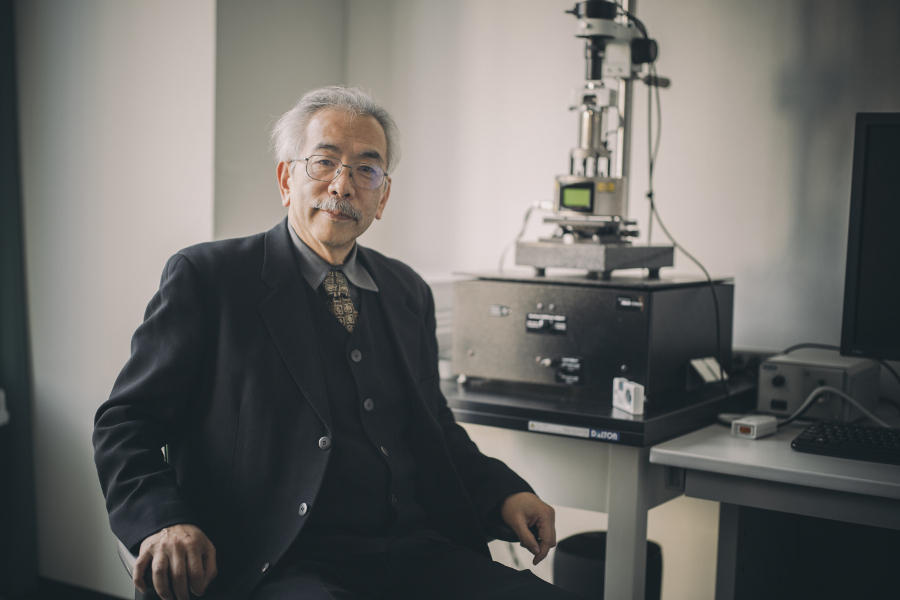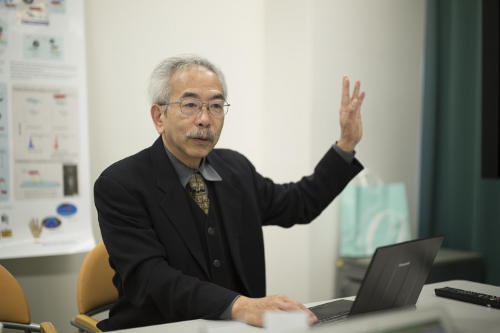"Biomolecular robotics, under development and discussion"

Akihiko Konagaya
Principal Investigator, "Co-creation of Molecular Robot ELSI and Real-time Technology Assessment Research", HITE Adopted Project. Professor, School of Computing, Tokyo Institute of Technology. Specializes in Molecular robotics which is the integration of Informatics and Life Sciences, and Intelligent Informatics.
A biomolecular robot with intelligence and senses that is being developed while nanobiotechnology and AI robot technology are being fused is about to open the door to the unknown. In order to spread this technology into society, we talked to Professor Akihiko Konagaya, who launched a platform to promote appropriate discussions from the viewpoint of ethics, law, economy, and education.
Give Intelligence to a Molecular Robot that Moves in the Body of an Organism
What is the molecular robot that you, Prof. Konagaya, are specialized in?
In a word, it is a "molecule sized robot with senses and intelligence". The purpose of molecular robotics is to provide a mechanism for molecular robots that works by giving them senses and intelligence so that they can get around inside the human body. An organism originally has the ability to create complex systems by combining biomolecules. By carrying out self-assembly and interacting with each other, biomolecules, such as DNA, can produce cells and organisms which move autonomously. We are learning the structures and the systems of these organisms, and trying to control the movement of a self-assembled molecular robot based on the design principle at the molecular level.
In 2016, the amoeba-robot team succeeded in developing several ameba-type molecular robots in the Grant-in-Aid for Scientific Research on Innovative Areas "Molecular Robotics". For the molecular robot created by Tohoku University, the kinesin motor and microtubule proteins, which will be a molecular actuator, is put into a liposome (bilayer membrane made of lipid molecules) with a diameter of about 20 micrometers which is slightly smaller than the bacteria cells. And a DNA fragment, which carries a signal, features a DNA clutch to control power transmission. When the DNA fragment which is carrying the signal attaches onto the DNA clutch in the liposome, the clutch turns on, then the microtubule moves resulting in deformation of the molecular robot. When the DNA fragment detaches from the DNA clutch, the clutch turns off and the deformation will not be carried out. Molecular robots using DNA fragments have been developed since the beginning of the year 2000, but these robots moved only randomly. Our ameba-type robot is the first molecular robot in the world that can control its own movement.
What is the current stage of molecular robotics research?
We are currently at the stage where elemental technologies and methodologies are established and being made ready to be used in various ways. Since the early 1990's, the research of DNA computers that process information using a large number of DNA fragments which form partial double helixes has advanced. By using this technology, and by realizing computer logic circuits using DNA fragments, it became available as "intelligence" of a molecular robot. In fact, the research group of the Tokyo Institute of Technology has succeeded in increasing the number of DNA fragments by 1,000 times in 30 minutes by inputting a DNA fragment as a signal into a molecular robot. Also, different DNA fragments can be grown from a single DNA fragment with a time difference, allowing it to have a function similar to a computer clock signal. Our future task is to enhance the types of molecular robot parts such as clutches and amplifier circuits which operate under the same conditions.
If we can develop molecules which are applicable for cancer diagnosis, antibody medicine, drug delivery systems etc. into molecular robots in the future, we will be able to have a tremendous impact on medical treatments and drug discovery. Students studying this field now are expanding their imaginations for things such as a molecular robot acting as an artificial antibody, and a molecular robot which is capable of photosynthesis.
Toward Molecular Robots Applications in society
It sounds like molecular robots feature considerably advanced technologies. What do you think about future utilization of such robots in society?
Although researchers have been thinking on a daily basis about the fabrication of molecular robots and the possibilities of their use, they do not have many points of view as to what kinds of impacts these technologies to be developed, or those which have already been developed, will have in society in terms of ethical, social and economic implications. We are concerned about compliance with ethical standards, in particular. So, we tend to be vigilant about exchanging opinions with non-professional people.
However, I believe that it is still necessary to discuss ethical considerations and other issues from the earliest stage of development. For example, we sometimes use microtubules taken from readily available bovine brains for experiments, but when we attempt to convert them to a different use for pharmaceuticals, our research efforts may be discarded because the bovine cells may be considered to be a risk of BSE. In this case, we have to restart the research from scratch starting from selection of the materials. In addition, one study conducted in Japan has developed an epoch-making therapeutic drug which strengthens the immune system by acting on the surface of cancer molecules. However, it is currently an extremely expensive treatment. Some people expressed concern that it may lead to a surge in medical costs. I believe that such issues are only one example of what happens when an idea which comes from the technology development side alone does not spread successfully to society.
If we can predict that there are dangerous traps in the future like this case, it is necessary to change the course at the early stages of research & development. Now, Japan is the world leader in the development of molecular robots. Therefore, we should not base our research solely on the initial concepts, but should also include human beings who actually use these robots from the very beginning stages of research. I would like to incorporate the viewpoints of, for example, what happens if we place a robot into a human body, and what we do about the development costs, and how we distribute and dispose of it. I would like to consider these issues from the very beginning.

Is that the reason you applied for HITE?
Yes, it is. Immediately after the launch of molecular robotics research, I participated in the "Molecular Programming Project" conference that was funded by the US National Foundation of Science. It was eye opening for me that the ethics experts have been participating in this project to provide an estimation of what will happen when new technology enters our society. The researchers have been reflecting these estimations into their research. After I returned to Japan, we tried to look for ethics experts, but we could not find common ground easily. However, at the AI ethics session of the Japan Society for Artificial Intelligence in 2016, I heard some details concerning the launch of HITE. I applied for the position with an expectation of meeting experts in the fields of ethics, social acceptance and scientific communication who may be able to cooperate with our research.
What kinds of activities are you planning to pursue at HITE in the future?
In HITE, I would like to highlight the issues from the viewpoint of laws, ethics and economy related to molecular robotics. In addition, I also would like to establish an educational system that integrates these areas and molecular robotics.
Currently, in collaboration with the group of Mr. Ryuma Shineha (Associate Professor, School of Mass Communication Studies, Department of Literature, Seijo University) with their goal of "Platform of Co-Creation and Communication for Real-Time Technology Assessment on Information Technology (CoRTTA)" within the HITE, we have been building a discussion platform called, "NutShell". This is a mechanism that allows stakeholders from various fields to participate in closed discussions. We have completed establishing a foundation for conducting interviews regarding molecular robots, as well as holding sessions on ethics and social acceptance in an international symposium of the molecular robot study groups. We believe that we will be able to connect both communities of molecular robots and scientific communication more effectively in the future
Also, it would be wonderful if a community was created that would lead to the creation of a platform used throughout the HITE Project to promote knowledge sharing and dissemination of information. I, myself, have also have been advocating the idea of a "knowledge grid (Fount of knowledge)" that is a source of new knowledge by widely sharing knowledge through computer networks. I am thrilled with the expectation of establishing such a place at this point.
Date of interview: January 24, 2016
This interview has been printed in our Program Introduction booklet Vol.01. If you would like to check the other articles please click the link below.
Human Information Technology Ecosystem (HITE) Program Introduction booklet - Vol.01 Vol.02